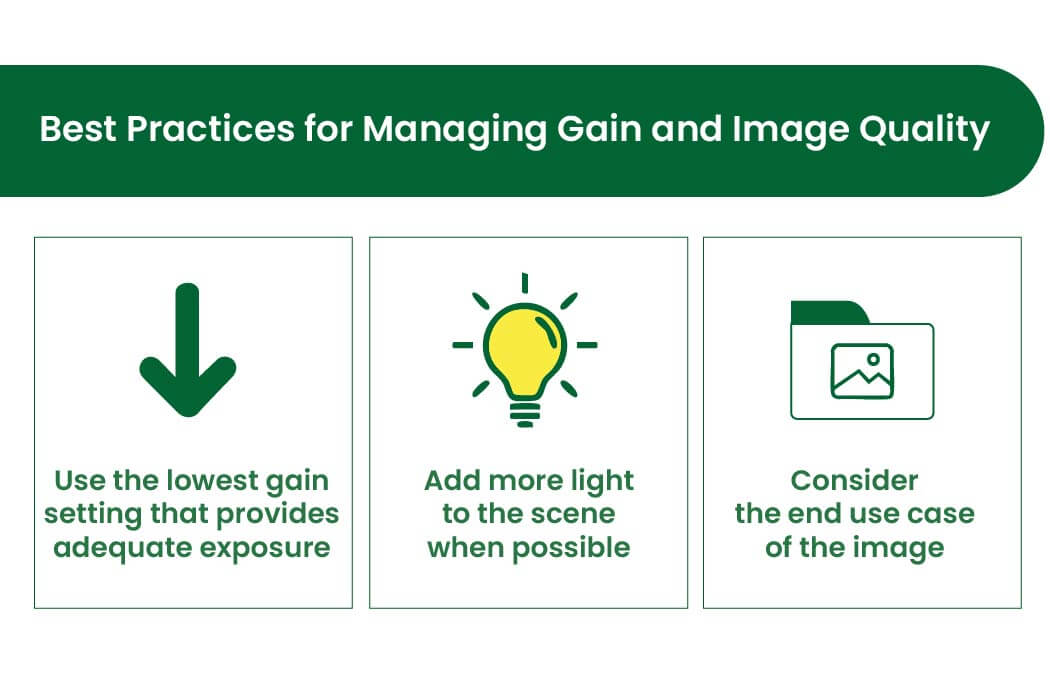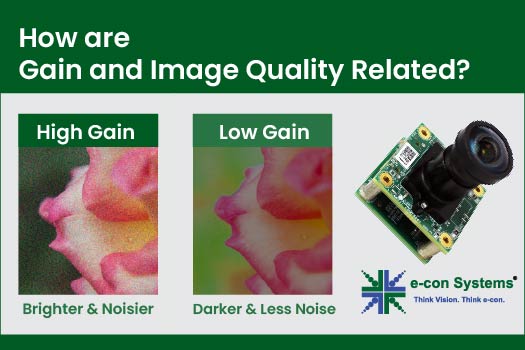Gain plays a major role in shaping the final image output captured by embedded vision systems. It refers to the amplification of the signal originating from the image sensor, similar to adjusting the volume on a speaker. These adjustments help optimize the imaging process for specific purposes, such as low-light scenarios, high-speed applications, unpredictable environments, and more.
While gain helps in achieving the desired brightness, it also introduces trade-offs that directly impact the quality of the image.
In this blog, you’ll learn about the relationship between gain and image quality to make well-informed decisions about your application’s imaging performance. But first, let’s look at the types of gain and their differences.
How Does Camera Gain Work?
Camera gain is a control parameter that adjusts the brightness of an image by amplifying the electrical signal generated by a camera sensor. When light hits the sensor, it produces a charge proportional to the light intensity. Next, the analog signal is turned into a digital value. Applying camera gain multiplies this signal either before or after digitization, making the image appear brighter without altering exposure time or aperture.
In embedded camera systems, camera gain is used when increasing exposure time isn’t feasible due to motion blur or when optical limitations constrain aperture adjustments. However, amplifying the signal also amplifies any noise present, which can degrade image quality if camera gain levels are too high.
Benefits of Using Camera Gain
Camera gain offers several benefits when applied with an understanding of its trade-offs. While it introduces signal amplification, the controlled use of camera gain contributes to image usability and system performance under various real-world conditions.
- Improved low-light performance: In scenes with limited illumination, camera gain enhances brightness without requiring longer exposure times. It helps establish motion clarity while maintaining higher frame rates in dynamic environments.
- High-speed imaging: At times, short exposure durations are necessary, such as capturing fast-moving objects. In these scenarios, camera gain compensates for the reduced light collection window. That way, it keeps the image adequately lit while avoiding motion blur.
- Dynamic adjustment: Camera gain settings can be fine-tuned alongside parameters like exposure and gamma during system setup. This helps calibrate the imaging pipeline to achieve better tonal balance, improved contrast, and sharper details in final outputs.
- Automated flexibility: In embedded systems with real-time scene analysis, camera gain control can be programmatically adjusted by the ISP or host software. It enables automatic adaptation to changing lighting conditions, ensuring consistent output without manual intervention.
Two Major Types of Gain
Analog gain
Analog gain refers to the adjustment of the signal at the hardware level before it is converted into digital data. This directly amplifies the electrical signal generated by the sensor in response to light exposure.
How it works:
The image sensor collects photons and converts them into an electrical charge. Then, the analog gain increases the voltage of this signal to brighten the image at the source.
The noise introduced at this stage is relatively minimal since the signal is amplified before digital conversion. Also, it retains the sensor’s inherent signal-to-noise ratio (SNR), producing images with less graininess compared to digital gain.
However, there is a physical limit to how much amplification can occur without saturating the sensor, leading to overexposure in bright areas.
Digital gain
Digital gain occurs after the analog-to-digital conversion, where the captured signal is represented as pixel data. This manipulates the digital image file by scaling its pixel values to achieve the desired brightness.
How it works:
The image data is multiplied by a constant factor in the digital domain, thereby brightening the final output. This provides a flexible and cost-effective way to adjust image brightness without requiring changes to hardware.
However, unlike analog gain, digital gain amplifies all aspects of the image, including pre-existing sensor noise. It can result in noticeable graininess, especially in low-light conditions.
Furthermore, excessive digital gain can lead to clipping in bright areas.
Key differences between analog and digital gain
| Aspect | Analog gain | Digital gain |
| Stage of Adjustment | Applied before analog-to-digital conversion | Applied after analog-to-digital conversion |
| Noise Impact | Amplifies signal with minimal noise impact | Amplifies both signal and noise, increasing graininess |
| Dynamic Range | Retains sensor’s dynamic range | Reduces dynamic range and lead to clipping |
| Flexibility | Limited by hardware capabilities | Highly flexible and software-controlled |
Primary Effects of Gain on Image Quality
Brightness vs. noise
Adjusting gain impacts brightness and noise levels in an image. Higher gain increases brightness by amplifying the sensor signal, but it also enhances noise, which can manifest as graininess in the image. Conversely, lower gain produces cleaner images with reduced noise but results in a darker appearance overall.
- High gain: Amplifies light and noise, leading to a brighter but noisier image
- Low gain: Maintains a cleaner image by minimizing noise, though the overall exposure is darker
Signal-to-noise ratio (SNR)
SNR is a measure of the clarity of the captured signal relative to the noise present. Gain impacts SNR proportionally by amplifying both the desirable signal and the inherent noise simultaneously. While gain adjustments can improve visibility, they do not enhance the underlying ratio of signal to noise.
Dynamic range
Dynamic range represents a camera’s ability to capture different levels of brightness in one image – from dark shadows to bright highlights. High gain settings can compress this range, making it tougher to capture details in bright areas without overexposing them. The reduction in dynamic range can lead to loss of detail in highlights, which ends up compromising the balance of the image.
Practical Implications of Gain for Image Capture
Optimal lighting conditions
When lighting conditions are ample, using lower gain levels is a practical strategy for capturing images with minimal noise and a wider range of detail. In such scenarios, the image sensor naturally receives enough light, enabling it to process the scene without the need for signal amplification. It results in a cleaner image output with richer colors and finer textures. Also, lower gain helps retain the dynamic range of the image, preserving details in shadowed and well-lit areas.
Embedded vision systems can ensure that the captured scene remains true to life, free from the artifacts that high gain might introduce, by avoiding unnecessary amplification. Lower gain also minimizes the risk of overexposure, which is important when dealing with scenes that have bright highlights or reflective surfaces.
Low-light scenarios
Capturing images in dimly lit environments often requires a careful adjustment of gain to make the scene adequately visible. Since low light provides insufficient illumination for the sensor, increasing gain becomes necessary to brighten the image. However, this adjustment brings challenges, as the amplification of the signal also increases noise, leading to grainier visuals.
The trick is to balance gain levels to make the image usable while keeping noise as unobtrusive as possible. In such cases, external factors like ambient light, exposure time, and sensor sensitivity come into play. Extending exposure time or using larger apertures can reduce reliance on gain. But, when these options are limited, such as in motion-intensive settings, gain adjustments become unavoidable.
Advanced noise reduction
Modern cameras integrate noise reduction techniques that can help counteract the negative effects of high gain. These algorithms analyze the image data and attempt to separate noise from the actual signal, smoothing out grainy textures and improving clarity. While noise reduction is invaluable for improving image quality, it has its trade-offs. In many cases, these algorithms can inadvertently soften fine details or introduce artifacts such as unnatural smudges or halos that detract from the image’s authenticity.
The effectiveness of noise reduction varies based on the complexity of the scene; for example, images with high levels of detail or patterns may be more prone to these artifacts. Camera engineers must weigh the benefits of reduced noise against the potential loss of fine texture and detail.
Best Practices for Managing Gain and Image Quality
 Use the lowest gain setting that provides adequate exposure
Use the lowest gain setting that provides adequate exposure
Start with the lowest gain level and increase it only as needed to achieve sufficient brightness. Lower gain minimizes noise, preserves details, and maintains a wider dynamic range. It is especially critical in professional imaging scenarios where clarity and detail are non-negotiable.
Add more light to the scene when possible
Instead of relying on gain adjustments, focus on improving the lighting conditions in the scene. Adding more light reduces the need for signal amplification, allowing the camera sensor to capture a cleaner image. For example, using additional light sources or better ambient lighting in industrial applications can enhance image quality without increasing noise.
Consider the end use case of the image
The acceptable level of noise in an image depends largely on its intended purpose. For example, surveillance footage may tolerate a higher noise level as long as key details remain discernible, whereas medical imaging needs minimal noise and maximum clarity. It is crucial to customize the gain settings to meet the requirements of the use case.
World-class customizable camera solutions by e-con Systems
Since 2003, e-con Systems has been designing, developing, and manufacturing custom and off-the-shelf OEM cameras. We offer hardware and software customization, including form factor optimization, ISP tuning, lens fixation, custom driver development, etc. Back by unparalleled expertise, our custom OEM cameras cater to different applications, such as quality inspection systems, diagnostic devices, interactive retail kiosks, parking management systems, and more.
As a dedicated camera partner, we combine deep technical knowledge with wide industry experience to provide end-to-end support throughout the development journey. This streamlines product integration and deployment, helping clients accelerate their time-to-market while minimizing development overheads.
See our Camera Selector Page for a full view of our products.
If you need help integrating the right camera into your embedded vision system, please email camerasolutions@e-consystems.com.

Prabu is the Chief Technology Officer and Head of Camera Products at e-con Systems, and comes with a rich experience of more than 15 years in the embedded vision space. He brings to the table a deep knowledge in USB cameras, embedded vision cameras, vision algorithms and FPGAs. He has built 50+ camera solutions spanning various domains such as medical, industrial, agriculture, retail, biometrics, and more. He also comes with expertise in device driver development and BSP development. Currently, Prabu’s focus is to build smart camera solutions that power new age AI based applications.




